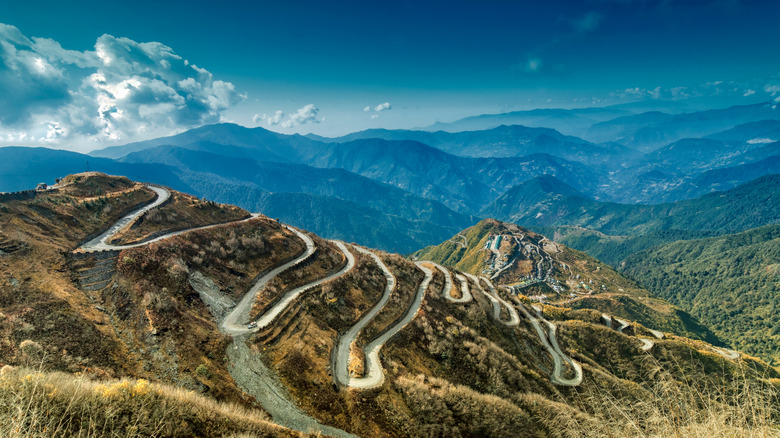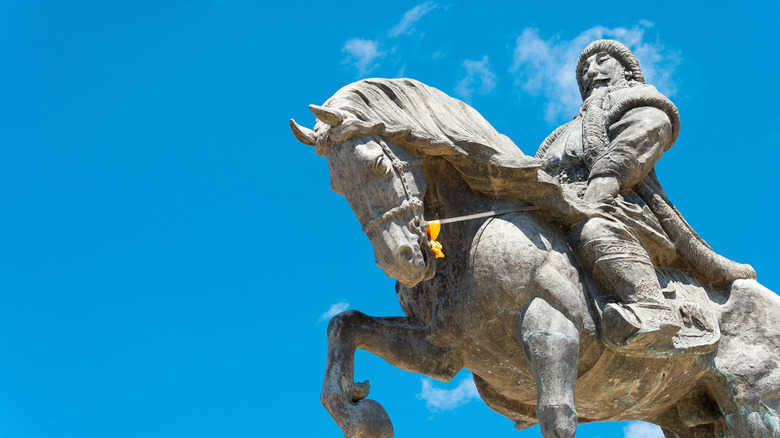The Mongol Empire And Its Impact On The Silk Road
At the very tail end of the 12th century, the Genghis Khan-led Mongols built the largest empire the world has ever seen. The Mongols used their incredible abilities on horseback to rapidly take over huge swaths of land, according to UNESCO. Of course, the Mongols weren't shy about killing anyone standing in the way of a potential prize and were even believed to have even killed all the cats and dogs they could find while taking over the city of Merv, in what is now Turkmenistan. However, they were known to spare those useful to their empire-building endeavors, namely able-bodied men and craftsmen.
Given their infamously brutal and efficient methods of taking over territories, it can be easy to overlook that the establishment of the Mongolian Empire ushered in a period known as the Pax Mongolica, which is Latin for "Mongol peace," per National Geographic. This left the Silk Road — the busiest and most important trade route in that part of the world — virtually unimpeded, which had both its benefits and its downfalls.
The upsides of the Mongol Empire controlled the Silk Road
Before the Mongols gained control of the entire route, the Silk Road had been a very dangerous place for travelers and traders alike. According to National Geographic, various tribes that lived along the Silk Road previously fought with each other and attacked travelers, which disrupted trade. When the Mongols managed to secure the entire route in 1227, there was no one to challenge them so the potential threat to travelers was no longer an issue.
This allowed a flood of goods to travel between Europe and Asia including jewels, horses, gun powder, and unsurprisingly, silk. Not only were goods exchanged, but traders like Marco Polo returned to Europe with stories of what they had encountered in Asia. The clear route also allowed Pope Innocent IV to send a representative to meet with Mongol leaders in Karakorum, an ancient city that was the capital of the Mongol Empire at the time (per Britannica). The representative was Friar John Carpini who met with the new Khan to try and protect Europe from what seemed an imminent westward expansion of the powerful Mongol empire. While this didn't work quite as they had hoped, due to Carpini not bringing a proper gift to the newly selected Mongol ruler, he did return with information that seemed to indicate that the mighty empire was in decline, per UNESCO.
The downsides of the Mongol controlled Silk Road
While Mongol control of the Silk Road led to some prosperous times for those living at either end of the legendary trade route. That same efficiency became one of the major factors in not just the Mongolian Empire's downfall, but also one of the darkest times in human history. According to National Geographic, the smooth operation of the Silk Road helped spread the bubonic plague.
In the 14th century after about 150 years of the Mongol Empire, the Black Death, as it came to be known, swept across the world. It's believed that the plague started somewhere in Central Asia and thanks to the frequent traffic traversing the Silk Road it made its way to Europe and eviscerated a massive portion of the population — as much as half of the continent, according to Science.
Researchers now believe that after the initial outbreak of the Black Death, a mutant strain of the same virus started making its way back east. This was determined by looking at victims in London, Barcelona, and the Russian city of Bolgar, and it's thought that this same strain could have been responsible for bubonic plague outbreaks across Asia in the last 200 years. It may even be responsible for a modern outbreak that occurred in Madagascar in 2015.


